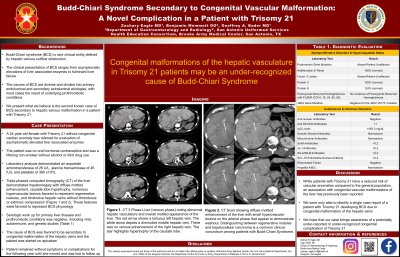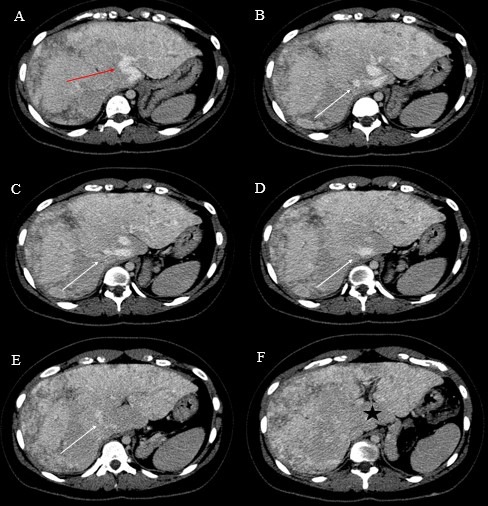Tuesday Poster Session
Category: Liver
P3872 - Budd-Chiari Syndrome Secondary to Congenital Vascular Malformation: A Novel Complication in a Patient with Trisomy 21
Tuesday, October 24, 2023
10:30 AM - 4:00 PM PT
Location: Exhibit Hall

Has Audio

Zachary Eagle, MD
San Antonio Uniformed Services Health Education Consortium (SAUSHEC)
San Antonio, TX
Presenting Author(s)
Award: Presidential Poster Award
Zachary Eagle, MD1, Geoff Bader, MD2
1San Antonio Uniformed Services Health Education Consortium (SAUSHEC), San Antonio, TX; 2Brooke Army Medical Center, San Antonio, TX
Introduction: Budd-Chiari syndrome (BCS) is rare clinical entity defined by hepatic venous outflow obstruction. The clinical presentation of BCS ranges from asymptomatic elevations of liver associated enzymes to fulminant liver failure. The causes of BCS are diverse and divided into primary endoluminal and secondary extraluminal etiologies, with most cases the result of underlying prothrombotic conditions. We present a what we believe is the second known case of BCS secondary to hepatic venous malformation in a patient with Trisomy 21.
Case Description/Methods: A 24-year-old female with Trisomy 21 without congenital cardiac anomaly was referred to Gastroenterology for evaluation of asymptomatic elevated liver associated enzymes. The patient was on oral hormonal contraceptive and was a lifelong non-smoker without alcohol or illicit drug use. Family history was non-contributory. Physical examination showed phenotypic Trisomy 21 features and non-tender hepatomegaly. Laboratory analysis demonstrated an aspartate aminotransferase of 26 U/L, alanine transaminase of 45 IU/L, and platelets of 380 x109/L. Triple-phased computed tomography of the liver demonstrated hepatomegaly with diffuse mottled enhancement with caudate lobe hypertrophy, numerous hypervascular lesions favored to represent regenerative nodules, and diminutive hepatic veins without thrombosis or extrinsic compression (Figures 1). Features were favored to represent BCS physiology Serologic work up for primary liver disease and prothrombotic conditions was negative, including viral, autoimmune, and genetic studies (Table 1). The cause of BCS was favored to be secondary to congenital malformation of the hepatic veins and the patient was started on apixaban. Our patient remained without symptoms or complications for the following year until she moved and was lost to follow up.
Discussion: While patients with Trisomy 21 have a reduced risk of vascular anomalies compared to the general population, an association with congenital vascular malformations of the liver has been reported. However, we were only able to identify a single case report of a patient with Trisomy 21 developing BCS due to congenital malformation of the hepatic veins. We hope that our case brings awareness of a potentially under-reported or under-recognized congenital complication of Trisomy 21.

Disclosures:
Zachary Eagle, MD1, Geoff Bader, MD2. P3872 - Budd-Chiari Syndrome Secondary to Congenital Vascular Malformation: A Novel Complication in a Patient with Trisomy 21, ACG 2023 Annual Scientific Meeting Abstracts. Vancouver, BC, Canada: American College of Gastroenterology.
Zachary Eagle, MD1, Geoff Bader, MD2
1San Antonio Uniformed Services Health Education Consortium (SAUSHEC), San Antonio, TX; 2Brooke Army Medical Center, San Antonio, TX
Introduction: Budd-Chiari syndrome (BCS) is rare clinical entity defined by hepatic venous outflow obstruction. The clinical presentation of BCS ranges from asymptomatic elevations of liver associated enzymes to fulminant liver failure. The causes of BCS are diverse and divided into primary endoluminal and secondary extraluminal etiologies, with most cases the result of underlying prothrombotic conditions. We present a what we believe is the second known case of BCS secondary to hepatic venous malformation in a patient with Trisomy 21.
Case Description/Methods: A 24-year-old female with Trisomy 21 without congenital cardiac anomaly was referred to Gastroenterology for evaluation of asymptomatic elevated liver associated enzymes. The patient was on oral hormonal contraceptive and was a lifelong non-smoker without alcohol or illicit drug use. Family history was non-contributory. Physical examination showed phenotypic Trisomy 21 features and non-tender hepatomegaly. Laboratory analysis demonstrated an aspartate aminotransferase of 26 U/L, alanine transaminase of 45 IU/L, and platelets of 380 x109/L. Triple-phased computed tomography of the liver demonstrated hepatomegaly with diffuse mottled enhancement with caudate lobe hypertrophy, numerous hypervascular lesions favored to represent regenerative nodules, and diminutive hepatic veins without thrombosis or extrinsic compression (Figures 1). Features were favored to represent BCS physiology Serologic work up for primary liver disease and prothrombotic conditions was negative, including viral, autoimmune, and genetic studies (Table 1). The cause of BCS was favored to be secondary to congenital malformation of the hepatic veins and the patient was started on apixaban. Our patient remained without symptoms or complications for the following year until she moved and was lost to follow up.
Discussion: While patients with Trisomy 21 have a reduced risk of vascular anomalies compared to the general population, an association with congenital vascular malformations of the liver has been reported. However, we were only able to identify a single case report of a patient with Trisomy 21 developing BCS due to congenital malformation of the hepatic veins. We hope that our case brings awareness of a potentially under-reported or under-recognized congenital complication of Trisomy 21.

Figure: Serial CT imaging (3 Phase Liver - venous phase) noting abnormal hepatic vasculature and overall mottled appearance of the liver. The red arrow shows a tortuous left hepatic vein. The white arrow depicts a diminutive middle hepatic vein. There was no venous enhancement of the right hepatic vein. The star highlights hypertrophy of the caudate lobe.
Disclosures:
Zachary Eagle indicated no relevant financial relationships.
Geoff Bader indicated no relevant financial relationships.
Zachary Eagle, MD1, Geoff Bader, MD2. P3872 - Budd-Chiari Syndrome Secondary to Congenital Vascular Malformation: A Novel Complication in a Patient with Trisomy 21, ACG 2023 Annual Scientific Meeting Abstracts. Vancouver, BC, Canada: American College of Gastroenterology.


